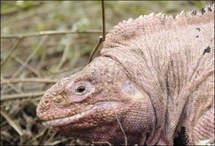
Researchers at first thought that the iguanas, which are pink with black spots, simply had skin pigmentation problems, Tapia said.
The first pink iguanas were discovered in 1986, and after years of research scientists concluded that it was a unique species.
"We have not yet determined the size of the population, but we estimate that it is small because we have only captured 36 pink iguanas for research up to now," Tapia said in a telephone interview.
The pink species can be up to 1.8 meters (6 feet) long as measured from tip to tail, and unlike the other land iguanas does not have a row of spines running up its back.
"It is a unique species," Tapia said. "But more research is needed to better determine its unique characteristics."
Made up of 13 main islands, in 1978 UNESCO declared the islands Patrimony of Humanity.
----------------------------
Image of a pink iguana (a Galapagos National Park picture), by Tui de Roy.
The first pink iguanas were discovered in 1986, and after years of research scientists concluded that it was a unique species.
"We have not yet determined the size of the population, but we estimate that it is small because we have only captured 36 pink iguanas for research up to now," Tapia said in a telephone interview.
The pink species can be up to 1.8 meters (6 feet) long as measured from tip to tail, and unlike the other land iguanas does not have a row of spines running up its back.
"It is a unique species," Tapia said. "But more research is needed to better determine its unique characteristics."
Made up of 13 main islands, in 1978 UNESCO declared the islands Patrimony of Humanity.
----------------------------
Image of a pink iguana (a Galapagos National Park picture), by Tui de Roy.









 Home
Home Politics
Politics









